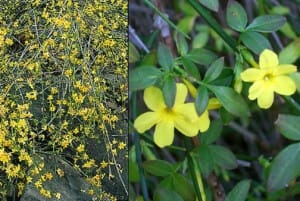Source(s): Jim Midcap, Extension Horticulturist, The University of Georgia College of Agricultural and Environmental Sciences.
Winter is a strange time to think of flowers in the landscape. Yet it can be a surprising awakening of the garden. Several types of trees, shrubs, vines, annuals and perennials bloom between fall and spring.
Here are some favorite winter bloomers.
Winter jasmine is an evergreen, arching shrub reaching 3 to 4 feet high and 4 to 6 feet wide. With the warm days of January and February, the red buds open into bright yellow, tubular flowers on the green stems.
The flowers open over a long time, with always a few open blooms once it starts. This plant flowers best in full sun. It’s well-adapted to banks where the ends of the branches root, starting new plants.
Winter daphne is an aristocrat in the plant world. This slow-growing, mounded evergreen reaches about 3 feet tall and a little less wide.
The clusters of tiny flowers form heads 1 to 2 inches across in solid white or pink-edged white flowers. The flowers stay in good condition for four to six weeks. The outstanding fragrance fills the area, too.
However, it’s not an easy plant to grow. It dislikes having its roots in wet soils. Plant it high in well-drained, amended soils in partial shade for best results.
Winter honeysuckle brings life to the garden with its sweet fragrance. The small, creamy flowers seldom attract attention, except from the insects. The plant is best placed in an out-of-the-way space.
It’s a tough, adaptable plant that reaches 6 to 10 feet tall in sun or shade. Tuck it away and let visitors try to find the source of the honeysuckle perfume.
Lenten rose is a foot-tall, delightful perennial that starts to bloom in January or February. This plant is easy to grow and only requires partial shade and occasional watering.
It rewards us with clusters of nodding terminal flowers 3 inches wide that are white to maroon, many with freckle spots inside. The flowers last eight weeks or more before turning green with the development of its inflated seed pods. The leathery, dark green leaves are attractive all year.
These few suggestions will enhance most winter gardens. Color and fragrance are both enjoyable during the warm days of winter.
If you plant in the fall, be sure to select plants that are mature enough to have developed flower buds, or you may have to wait another growing season to enjoy their blooms.
Resource(s):
Landscape Plants for Georgia
Center Publication Number: 156
- Fall Perfect for Planting Trees - September 24, 2013
- Fall Berry Color - September 24, 2013
- Discover the Hydrangeas - September 23, 2013
